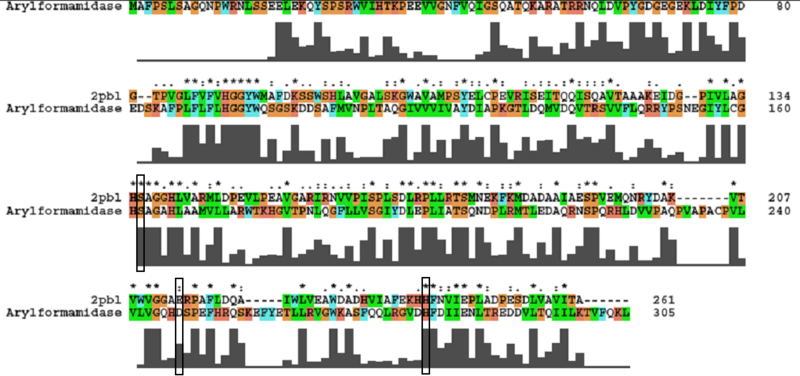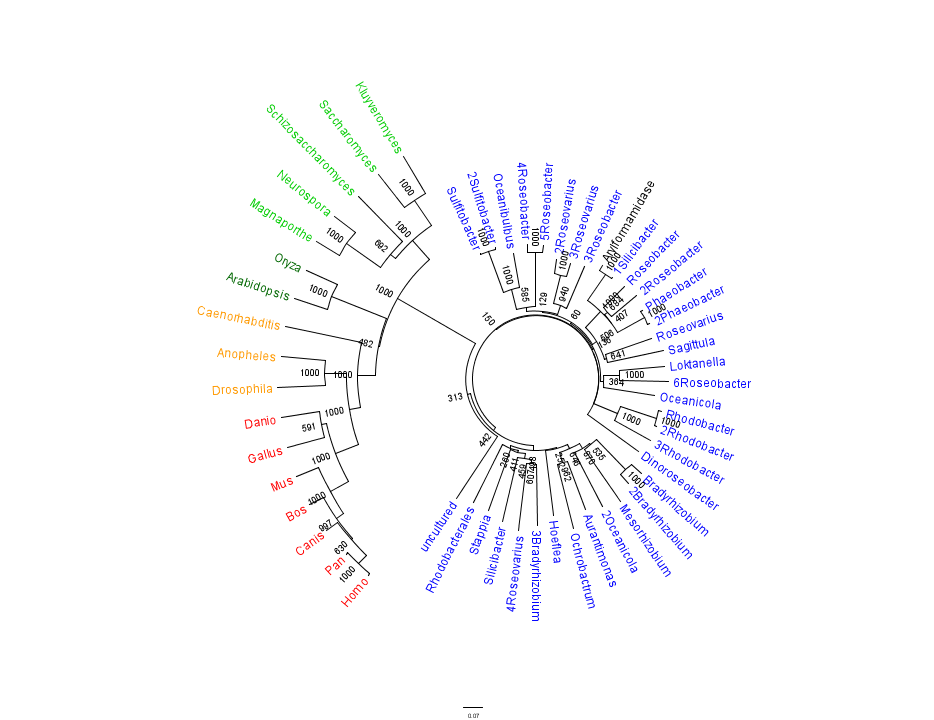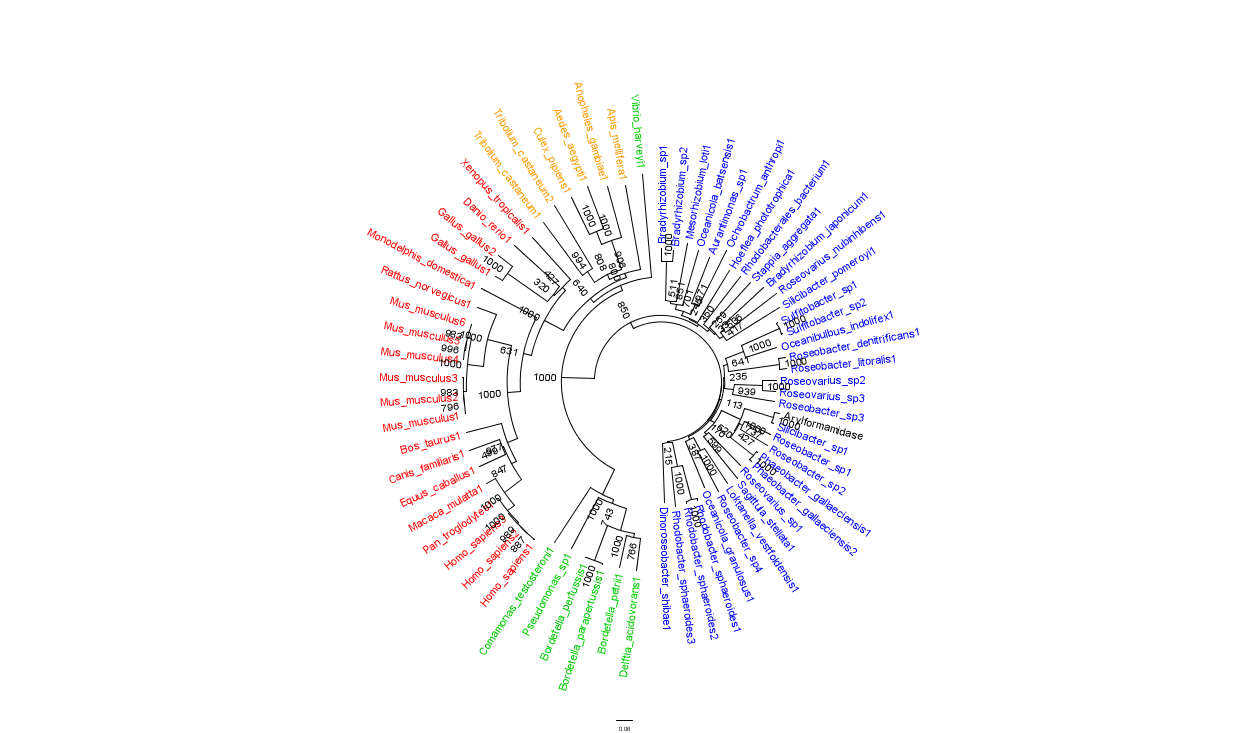Arylformamidase Results: Difference between revisions
Thomasparker (talk | contribs) No edit summary |
No edit summary |
||
| Line 13: | Line 13: | ||
[[Image:HSL_alignment.png|centre|framed|'''Figure 2:''' ''Alignment with other HSL family members.'']] | [[Image:HSL_alignment.png|centre|framed|'''Figure 2:''' ''Alignment with other HSL family members.'']] | ||
== Sequence & Homology == | |||
Figure 1 shows that the query sequence "Arylformamidase" grouped with bacterial sequences, shown cloured in Blue. The bootstrap values reveal low confidence with many of the nodes occurring lower down on the phylogenetic tree revealing a possible explanation for certain closely related species to be grouped into separate clades. However, despite low bootstrap scores, the grouping does reliably separate prokaryotes from eukaryotes and the eukaryotes themsselves are clearly distinguished between yeasts and moulds (shown in Green), plants (Dark Green), invertebrates (Orange) and vertebrates (shown in Red). | |||
'''Figure 1.''' | |||
[[Image:NewBOOT1000tree.png]] | |||
''Unrooted phylogenetic tree of highest scoring results from a BLASTP search of bacterial sequnces using a non-redundant database and homologous eukaryotic sequences sourced from NCBI HomoloGene. Branch lengths are related to phylogenetic distance and node numbers refer to Bootstrap values. On this tree "Arylformamidase" refers to the Silicibacter species from which our sequence originated. The colour coding distinguishes prokaryotic organisms shown in Blue, from eukaryote yeasts and moulds (shown in Green), plants (Dark Green), invertebrates (Orange) and vertebrates (shown in Red).'' | |||
To further elucidate the phylogeny of the Arylformamidase protein, top scoring matches of bacterial homologues were appended with top scoring matches of eukaryotic homologues. Figure 2 is largely consistent with traditional taxonomic groupings of organisms. Specifically, it reveals greater statistical confidence in the separation of prokaryotes (Blue and Green) and eukaryotes (invertebrates are shown in Orange; vertebrates are in Red). | |||
'''Figure 2.''' | |||
[[Image:BacterANDhomoTREE.jpg]] | |||
''Unrooted phylogenetic tree of highest scoring results from a BLASTP search of bacterial sequences and highest scoring results of a BLASTP search on a homologous human sequence. Branch lengths are related to phylogenetic distance and node numbers refer to Bootstrap values. On this tree "Arylformamidase" refers to the Silicibacter species from which our sequence originated. The colour coding distinguishes prokaryotes (Blue and Green) and eukaryotes (invertebrates are shown in Orange; vertebrates are in Red).'' | |||
In general, members of the same genus have been grouped together on these phylogenetic trees with some notable exceptions. For instance, Silicibacter, the species from which we derived our protein, occurs on disparate branches of the tree. | |||
[[Arylformamidase | Return to the main page...]] | [[Arylformamidase | Return to the main page...]] | ||
Revision as of 09:22, 3 June 2008
most similar sequence - catalytic triad, structure with highlighted
The most similar sequence with functional information available was that of an arylformamidase isolated from the liver of Mus musculus (see figure ...). A functional analysis of this protein has been performed identifying a catalytic triad using site-directed mutagenesis (Pabarcus et al. 2007). Conservation of this catalytic triad with 2pbl was assessed. Both residues S162 and H279 were found to be conserved in relatively conserved regions of the alignment. However, D247 had undergone a semi-conservative substitution. These residues correlated to S136, E214 and H241 of 2pbl which were subsequently located on the tertiary structure and determined to be sufficiently proximal to one another for catalysis (see figure...).
most similar structure - catalytic triad, structure with highlighted
2pbl was found to share most structural similarity with a thermostable carboxylesterase from an uncultured archaeon (PDB ID: 2c7b; see figure ...). 2c7b shares a 16% sequence identity with 2pbl. From its structure, a catalytic triad has been identified (how?). To substantiate any functional similarity between 2pbl and 2c7b, conservation of the 2c7b catalytic triad was analysed (see figure ...). All three residues were found to be conserved, though H... and E... were found to match is less conserved regions.
Sequence & Homology
Figure 1 shows that the query sequence "Arylformamidase" grouped with bacterial sequences, shown cloured in Blue. The bootstrap values reveal low confidence with many of the nodes occurring lower down on the phylogenetic tree revealing a possible explanation for certain closely related species to be grouped into separate clades. However, despite low bootstrap scores, the grouping does reliably separate prokaryotes from eukaryotes and the eukaryotes themsselves are clearly distinguished between yeasts and moulds (shown in Green), plants (Dark Green), invertebrates (Orange) and vertebrates (shown in Red).
Figure 1.
Unrooted phylogenetic tree of highest scoring results from a BLASTP search of bacterial sequnces using a non-redundant database and homologous eukaryotic sequences sourced from NCBI HomoloGene. Branch lengths are related to phylogenetic distance and node numbers refer to Bootstrap values. On this tree "Arylformamidase" refers to the Silicibacter species from which our sequence originated. The colour coding distinguishes prokaryotic organisms shown in Blue, from eukaryote yeasts and moulds (shown in Green), plants (Dark Green), invertebrates (Orange) and vertebrates (shown in Red).
To further elucidate the phylogeny of the Arylformamidase protein, top scoring matches of bacterial homologues were appended with top scoring matches of eukaryotic homologues. Figure 2 is largely consistent with traditional taxonomic groupings of organisms. Specifically, it reveals greater statistical confidence in the separation of prokaryotes (Blue and Green) and eukaryotes (invertebrates are shown in Orange; vertebrates are in Red).
Figure 2.
Unrooted phylogenetic tree of highest scoring results from a BLASTP search of bacterial sequences and highest scoring results of a BLASTP search on a homologous human sequence. Branch lengths are related to phylogenetic distance and node numbers refer to Bootstrap values. On this tree "Arylformamidase" refers to the Silicibacter species from which our sequence originated. The colour coding distinguishes prokaryotes (Blue and Green) and eukaryotes (invertebrates are shown in Orange; vertebrates are in Red).
In general, members of the same genus have been grouped together on these phylogenetic trees with some notable exceptions. For instance, Silicibacter, the species from which we derived our protein, occurs on disparate branches of the tree.




